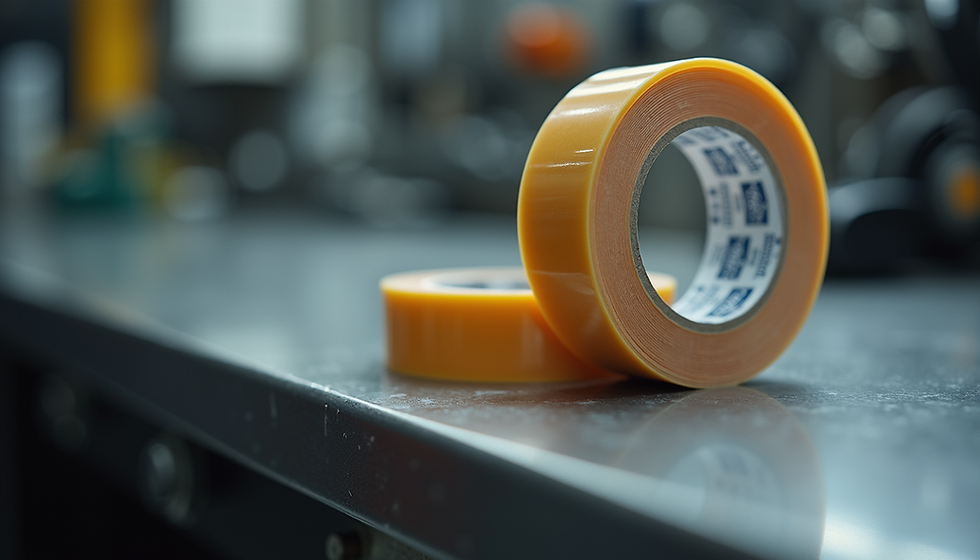The Power of Butyl Tape: Exploring Its Hidden Features and Applications
- Snehil Jain
- Mar 19
- 4 min read
Butyl tape is often overlooked, but it's a vital asset in construction and repair. This unique tape boasts exceptional qualities that make it versatile across various industries. This blog post will highlight its important features and numerous applications, showcasing why it should be at the forefront of your toolkit.
What is Butyl Tape?
Butyl tape is an adhesive tape made from butyl rubber. Known for its superior waterproof and bonding properties, this tape is coated with a strong adhesive that sticks to multiple surfaces, ensuring a reliable seal. Its applications span construction, automotive repair, and even DIY home projects.
Key Features of Butyl Tape
1. Waterproof and Weather Resistant
Butyl tape excels in waterproofing. Once applied, it seals tightly to prevent water leaks, making it ideal for outdoor use. For instance, it's often used for sealing roof seams and window frames, where it protects against rain and snow.
In fact, studies show that roofs sealed with butyl tape have a significantly reduced leak rate, with some reports indicating up to a 90% decrease in water infiltration over a single year. Its resistance to UV rays and temperature fluctuations also helps it last longer than traditional sealing methods.
2. Excellent Adhesion
Butyl tape forms a strong bond with various materials, including metal, wood, glass, and plastic. Its excellent adhesion makes it the preferred choice for many repair projects. For instance, construction professionals often use it for HVAC duct sealing, where a secure bond is critical to maintain energy efficiency.
Its tacky surface allows for quick application, making it especially useful in urgent repairs. A fast fix can mitigate potential damage, which can save companies thousands of dollars in repair costs and downtime.
3. Flexibility
Unlike many traditional adhesives that harden and crack over time, butyl tape stays flexible. This quality allows it to handle movement without breaking its bond. It's particularly beneficial in applications where materials expand or contract due to temperature changes, like exterior siding.
With its high flexibility, butyl tape can endure up to 1,000 cycles of movement without failing, ensuring a long-lasting seal.
4. Non-Corrosive
Butyl tape is non-corrosive, so it won’t negatively affect metals and other materials. This feature is essential in construction, where any harmful reactions could compromise structural integrity. It's often used in plumbing applications, safeguarding pipes from corrosion and maintaining longevity.
Applications of Butyl Tape
1. Roofing
In the roofing sector, butyl tape is frequently used to seal joints and seams, ensuring they remain waterproof. For example, it provides a strong seal around vent pipes, preventing leaks during heavy rains. The flexibility of butyl tape helps it move with the roof materials, significantly lowering the chances of cracking or peeling.
2. Automotive Repair
Butyl tape is widely used in the automotive industry for sealing windshields and doors. This tape not only keeps out water and air but also enhances comfort in vehicles. In fact, car manufacturers often rely on butyl tape for its ability to endure the heat from engines, ensuring that the seals remain effective over time.
Additionally, it has been shown to withstand temperatures ranging from -40°F to 200°F, making it suitable for various climates.
3. Construction
In construction, butyl tape is a versatile adhesive for sealing HVAC ducts, insulating pipes, and mounting siding. Its ability to bond with different materials means it can be used for a variety of projects, from large commercial constructions to small DIY tasks. This adaptability makes it invaluable for builders and contractors looking for reliable performance.
4. DIY Projects
Homeowners quickly discover the benefits of butyl tape for everyday repairs. Whether patching a leaky roof or sealing windows, it offers accessible solutions that yield long-lasting results. Its easy application and quick drying make it an excellent choice for last-minute fixes.
How to Use Butyl Tape
Applying butyl tape is straightforward. Follow these steps for the best results:
Surface Preparation: Clean the surfaces to ensure they are dry and free from debris. Proper cleaning is crucial for optimal adhesion.
Cut to Length: Measure and cut the tape to the desired length, ensuring it is suitable for the application.
Application: Press the tape firmly on the surface, smoothing out air bubbles with a roller or flat tool to enhance adhesion.
Trim Excess: After applying, cut off any leftover tape for a neat finish.
Curing Time: Allow the tape to cure for the recommended duration before exposing it to moisture, usually around 24 hours.
Why Choose Butyl Tape Over Other Adhesives?
Butyl tape provides a combination of benefits unmatched by typical adhesives. While many glues can dry out and become brittle, butyl tape maintains its flexibility and strength in varying conditions.
Additionally, its versatility across industries—from automotive to construction—makes it a valuable tool for anyone. According to industry surveys, professionals who use butyl tape report a 75% satisfaction rate, citing its reliability and ease of use.
Final Thoughts
Butyl tape delivers waterproofing, flexibility, and excellent adhesion all in one product. Its diverse applications across roofing, automotive repair, construction, and DIY projects demonstrate its exceptional quality.
Whether you are a professional in the field or a homeowner tackling a repair, embracing butyl tape can help you achieve effective results effortlessly. Unleash the power of this adhesive and discover how it can elevate your projects.

In a world filled with adhesive products, butyl tape stands out as a dependable choice that deserves more attention. Whether you're working on large-scale repairs or small projects at home, this tape has the potential to transform how you approach sealing and bonding tasks.



Comments